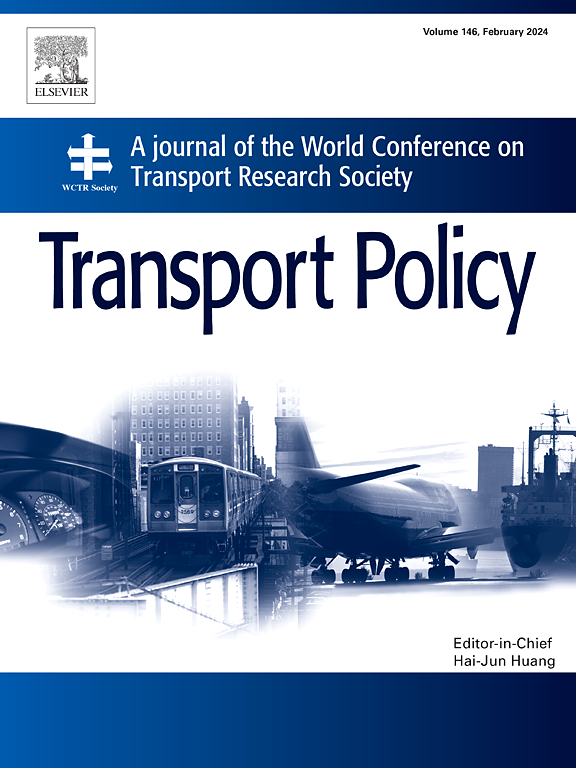Analyzing predictive factors influencing helmet-wearing behavior among E-bike riders
IF 6.3
2区 工程技术
Q1 ECONOMICS
引用次数: 0
Abstract
E-bikes revolutionize urban transport by offering an affordable and cost-effective alternative. However, poor helmet-wearing habits pose significant safety concerns, requiring effective interventions to mitigate head injuries and fatalities. This study investigated key factors predicting helmet-wearing behavior among e-bike riders in Guangdong Province, China, based on data from 14,762 survey valid responses. Logistic regression and three machine learning models: Random Forest (RF), XGBoost, and Support Vector Machine (SVM) were applied to predict helmet use and identify associated risk factors, with the RF model demonstrating superior predictive performance, achieving 91 % accuracy and 97 % Area Under the Curve (AUC). Using SHAP analysis, the study interpreted the influence of each factor based on the RF model revealing gender, riding experience, age group, average monthly income, policy management, and safety activity effectiveness as significant predictors of helmet-wearing behavior. For instance, SHAP waterfall plots for the first dataset showed that being male and receiving safety education through new media (e.g., WeChat, Weibo) raised the likelihood of non-helmet use by +0.03 and + 0.01, respectively. SHAP dependence plots further uncovered complex non-linear correlations, highlighting those males, inexperienced riders, and younger riders (under 18, 18–25, and 26–35) were less likely to wear helmets. Heatmap analysis indicated that diverse safety education methods combined with enriched content were strongly associated with increased helmet-wearing. Findings suggest that targeted safety campaigns, improved policy management, and stricter enforcement, supported by regular monitoring and evaluation, are essential to reduce non-helmet use and improve e-bike rider safety. Future research should use longitudinal studies and e-bike crash data to assess how safety education and policy interventions affect helmet-wearing patterns, crash rates, and injury severity over time.
影响电动自行车骑行者头盔佩戴行为的预测因素分析
电动自行车提供了一种经济实惠的替代方案,彻底改变了城市交通。然而,不良的头盔佩戴习惯构成了严重的安全问题,需要有效的干预措施来减轻头部伤害和死亡。本研究基于14762份有效问卷调查数据,调查了影响广东省电动自行车骑行者头盔佩戴行为的关键因素。应用逻辑回归和三种机器学习模型:随机森林(RF)、XGBoost和支持向量机(SVM)来预测头盔的使用并识别相关的风险因素,RF模型显示出卓越的预测性能,准确率达到91%,曲线下面积(AUC)达到97%。使用SHAP分析,研究基于RF模型解释了每个因素的影响,显示性别,骑行经验,年龄组,平均月收入,政策管理和安全活动有效性是头盔佩戴行为的重要预测因素。例如,第一个数据集的SHAP瀑布图显示,男性和通过新媒体(如微信、微博)接受安全教育的人不戴头盔的可能性分别提高了+0.03和+ 0.01。SHAP依赖性图进一步揭示了复杂的非线性相关性,突出显示男性、缺乏经验的骑手和年轻骑手(18岁以下、18 - 25岁和26-35岁)不太可能戴头盔。热图分析表明,多样化的安全教育方法和丰富的内容与头盔佩戴的增加密切相关。研究结果表明,在定期监测和评估的支持下,有针对性的安全运动、改进的政策管理和更严格的执法,对于减少不戴头盔的使用和提高电动自行车骑行者的安全性至关重要。未来的研究应该使用纵向研究和电动自行车碰撞数据来评估安全教育和政策干预如何随着时间的推移影响头盔佩戴模式、碰撞率和伤害严重程度。
本文章由计算机程序翻译,如有差异,请以英文原文为准。
求助全文
约1分钟内获得全文
求助全文
来源期刊

Transport Policy
Multiple-
CiteScore
12.10
自引率
10.30%
发文量
282
期刊介绍:
Transport Policy is an international journal aimed at bridging the gap between theory and practice in transport. Its subject areas reflect the concerns of policymakers in government, industry, voluntary organisations and the public at large, providing independent, original and rigorous analysis to understand how policy decisions have been taken, monitor their effects, and suggest how they may be improved. The journal treats the transport sector comprehensively, and in the context of other sectors including energy, housing, industry and planning. All modes are covered: land, sea and air; road and rail; public and private; motorised and non-motorised; passenger and freight.
 求助内容:
求助内容: 应助结果提醒方式:
应助结果提醒方式:


